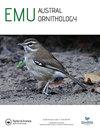澳大利亚干旱地区鸟类的生活史特征和警报呼叫
IF 1.1
4区 生物学
Q3 ORNITHOLOGY
引用次数: 0
摘要
在被捕食物种中,当它们受到威胁时,个体往往会发出警报。在鸟类中,这种信号通常是声音信号,提醒同种动物注意威胁的存在。接收者对这些叫声的反应可能包括逃到掩体或接近捕食者。虽然大多数鸟类在受到威胁时会发出警报,但并不是所有物种都这样做。我们使用澳大利亚干旱地区的鸟类(n = 171)来验证鸣叫行为是由生态、行为和形态特征决定的假设。89%的鸟类会发出警报,这凸显了这种行为的普遍性。我们的研究发现了三个变量——食物种类的数量、流动性和繁殖系统——它们与预测这些物种的报警行为有关。警报呼叫与这些关键生命史属性的对应关系,让我们深入了解发出警报呼叫的好处,以及产生这种行为的进化过程。本文章由计算机程序翻译,如有差异,请以英文原文为准。
Life history characteristics and alarm calling in Australian arid-zone birds
ABSTRACT In prey species, it is often the case that individuals give alarms when they are threatened. In birds, such signals are frequently vocal signals that alert conspecifics to the presence of a threat. The responses to these calls by receivers may include fleeing to cover or approaching to mob the predator. Although most birds do give alarm calls when threatened, not all species do. We used Australian arid-zone bird species (n = 171) to test the hypothesis that alarm calling behaviour is determined by ecological, behavioural, and morphological characteristics. Eighty-nine percent of birds analysed possessed an alarm call, highlighting the prevalence of this behaviour. Our study found three variables – number of food types eaten, mobility, and breeding system – that were associated with predicting alarm calling behaviour in these species. The correspondence of alarm calling with these key life history attributes provides insight into benefits of having alarm calls and the evolutionary processes that have given rise to this behaviour.
求助全文
通过发布文献求助,成功后即可免费获取论文全文。
去求助
来源期刊

Emu-Austral Ornithology
生物-鸟类学
CiteScore
2.00
自引率
7.70%
发文量
33
审稿时长
>12 weeks
期刊介绍:
Emu – Austral Ornithology is the premier journal for ornithological research and reviews related to the Southern Hemisphere and adjacent tropics. The journal has a long and proud tradition of publishing articles on many aspects of the biology of birds, particularly their conservation and management.
 求助内容:
求助内容: 应助结果提醒方式:
应助结果提醒方式:


